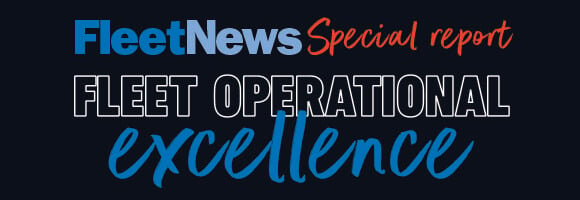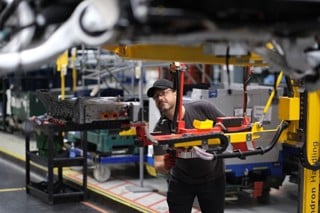This feature was taken from our special Fleet Operational Excellence report

The modern fleet decision-maker has become used to dealing with an ever-changing world, as the effects of seismic events such as the Covid pandemic and the war in Ukraine have filtered through in recent years.
More specific challenges have come from the drive to electrify as well as rising costs within the supply chain – factors which are increasingly having an impact on the overall costs of running a fleet.
“As a result, fleets are having to continually review and carefully manage budgets,” says Christopher Caddick, head of business development at JCT600 Vehicle Leasing Solutions.
He has witnessed funding choices being made because they present the best current option, rather than being best for each individual fleet.
“One of the biggest factors influencing funding decisions is the Zero-Emission Vehicle (ZEV) Mandate, which is impacting the availability of internal combustion engine (ICE) vehicles, particularly when it comes to light commercial vehicles (LCVs),” adds Caddick.
“Manufacturers are essentially forcing the hands of fleets to take electric vehicle (EV) products by only accepting orders where a percentage are EV, or reducing terms on ICE vehicles where they are not ordering any EVs.
“Overall, the ongoing economic instability, increased cost of the asset, rising funding costs and navigating the ZEV Mandate or availability of vehicles that the fleet wants or needs are all having an influence on the funding decisions they are having to make.”
Operational and small-to-medium enterprise (SME) fleets which do not have deep pockets plus shareholder directives on transitioning to EVs “at any cost” are those that are currently bearing the brunt worst, he says.
The transition to EVs, in particular, is driving new trends in fleet funding, says Volkswagen Financial Services (VWFS) Fleet.
“Perhaps most significantly, we’re seeing many customers switch from using effective rental to wholelife cost as they assess fleet funding strategies,” says Emma Loveday, senior fleet consultant at VWFS Fleet.
“This is helping many fleet operators make the business case for EVs and supporting with cost management.
“We’re also seeing increased demand for longer lease cycles for EVs to help customers further manage lease costs.
“At VWFS Fleet, we’ve responded to this demand proactively, offering longer lease cycles up to seven years.”
Spreading the cost
As BEVs do not typically face the same maintenance cost curve as ICE vehicles, customers are able to spread the monthly lease cost over a longer agreement and reduce the financial impact of the electric transition, she adds.
VWFS Fleet has also seen fleets which traditionally outright purchase diesel LCVs look at using business contract hire instead to procure electric vans.
“This helps fleets manage costs, as eLCVs often have a higher purchase price than their ICE counterparts,” says Loveday.
Venson Automotive Solutions also believes that a move to contract hire is a key fleet trend because it takes away the burden of risk from the organisation, with that risk sitting with the leasing company instead.
Fleets are also favouring contract hire because it gives an organisation a clear understanding of the costs each month, making budgeting easier which is important given the current volatile marketplace.
“There has been some shift with organisations moving from outright purchase to contract hire as they decide to use the cash to invest in their business rather than have it tied up in assets,” says Samantha Roff, managing director of Venson Automotive Solutions.
“With much focus on electric cars, salary sacrifice has also had a resurgence and is being used by organisations to help support employee reward schemes which, in turn, can have a positive impact on staff retention and recruitment.
“And for certain industries, contract purchase is the chosen method of funding. For example, charities and some healthcare organisations because of the treatment of VAT.”
Regular reviews
The changing landscape means it is important that fleet decision-makers should regularly review their funding methods to ensure they use the best one(s) to meet their requirements.
A key step is to understand what the strategic objectives are for their organisation along with the operational requirements of the fleet so the most beneficial funding method can be matched to business needs.
A full audit of how a fleet’s vehicles are funded together with their usage and length of replacement cycle should be undertaken.
“Customers can choose from a number of options. Each funding solution will have specific advantages and drawbacks, so it is essential to carefully consider individual business requirements,” says Loveday.
Analysis of a fleet would also provide the information needed to inform future strategies.
“You clearly need to ensure you’re investing in the right areas, and having a grasp on the vehicles making up the fleet ensures that replacements or additions are not made unnecessarily,” says Roff.
“It is equally important to understand the operational requirements of the vehicles. For example, does the manufacturer have service centres in the geographical area that drivers are operating in?
“Equally important is the manufacturer’s track record – and having access to maintenance history of the same vehicles definitely helps with decision-making.”
ZEV mandate opportunities
The desire for manufacturers to hit their ZEV Mandate targets means there are currently opportunities for fleets to capitalise on the increased availability and attractive discounts on EVs, says Caddick.
“There is also strong availability of EVs through short- and long-term rental companies as they continue to transition their own fleets to EV at pace,” he adds.
Caddick also believes those fleets which are not yet ready to switch to electric vehicles – or are slowing down their transition as a result of operational challenges – must work with their funders, fleet management companies, manufacturers and dealers to ensure they are getting the vehicles they want and need.
“Even then, they may have to make compromises,” he adds. JCT600 VLS is seeing some customers extend existing leases while others are terminating early to order new ICE vehicles before the ZEV Mandate gets tougher to manage.
“Ultimately, you need to align the objectives of the business with your fleet as closely as possible, and the only way to do this is by working with partners you trust that will commit the time and energy to do this with you,” adds Caddick.
Boost efficiency, cut costs and improve compliance across all areas of your business with the Fleet News Operational Excellence report.
Delve into crucial topics for effective fleet management, including electrification, digitalisation, alternative funding, and compliance. To give you an edge, we've gathered insights from top industry experts who reveal their best practices and innovative strategies.
Dive into these highlights and read the full report to unlock the secrets of running a more efficient and effective fleet operation.
























Login to comment
Comments
No comments have been made yet.